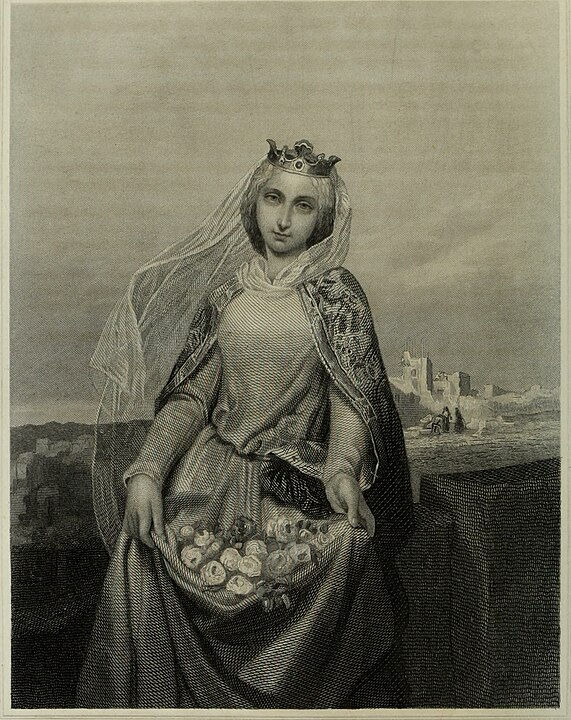Saint Elizabeth of Hungary
Feast Day: November 17
Elizabeth was the daughter of the just and pious Andrew II, king of Hungary, the niece of Saint Hedwig, and the sister of the virtuous Bela IV, king of Hungary, who became the father of Saint Cunegundes and of Saint Margaret of Hungary, a Dominican nun. Another of her brothers was Coloman, King of Galicia and Prince of Russia, who led an angelic life amid the multiple affairs of the world and the troubles of war.
She was betrothed in infancy to Louis, Landgrave of Thuringia, and brought up from the age of four in his father’s court. Never could she bear to adopt the ornaments of the court for her own usage, and she took pleasure only in prayer. She would remove her royal crown when she entered the church, saying she was in the presence of the Saviour who wore a crown of thorns. As she grew older, she employed the jewels offered to her for the benefit of the poor. Not content with receiving numbers of them daily in her palace, and relieving all in distress, she built several hospitals, where she herself served the sick, bathing them, feeding them, dressing their wounds and ulcers. The relatives of her fiancé tried to prevent the marriage, saying she was fit only for a cloister; but the young prince said he would not accept gold in the quantity of a nearby mountain if it were offered him to abandon his resolution to marry Elizabeth.
Once as she was carrying in the folds of her mantle some provisions for the poor, she met her husband returning from the hunt. Astonished to see her bending under the weight of her burden, he opened the mantle and found in it nothing but beautiful red and white roses, though it was not the season for flowers. He told her to continue on her way and took one of the marvelous roses, which he conserved all his life. She never ceased to edify him in all of her works. One of her twelve excellent Christian maxims, by which she regulated all her conduct was, “Often recall that you are the work of the hands of God and act accordingly, in such a way as to be eternally with Him.”
When her pious young husband died in Sicily on his way to a Crusade with Emperor Frederick, she was cruelly driven from her palace by her brother-in-law. Those whom she had aided showed nothing but coldness for her; God was to purify His Saint by harsh tribulations. She was forced to wander through the streets with her little children, prey to hunger and cold. The bishop of Bamberg, her maternal uncle, finally forced the cruel prince to ask pardon for his ill-treatment of her, but she voluntarily renounced the grandeurs of the world and went to live in a small house she had prepared in the city of Marburg. There she practiced the greatest austerities. She welcomed all her sufferings and continued to be the mother of the poor, distributing all of the heritage eventually conceded to her and converting many by her holy life. She died in 1231, at the age of twenty-four.
Patronage
Bakers – Catholic Charities – Secular Franciscan Order
Source: sanctoral.com

Birthplace
Born
7 July 1207
Pozsony, Kingdom of Hungary
(Bratislava, Slovakia)
Death
17 November 1231 (Age 24)
Marburg, Landgraviate of Thuringia (Germany)
Canonized
27 May 1235 (Pope Gregory IX)
Shrine/Relics/Tomb
Marburg, Germany
Learn more:
Catholic World Report
Lessons in generosity from St. Elizabeth of Hungary – CatholicWorldReport.com
Elizabeth built a culture of life in her region by giving to the poor, nursing the sick, and loving as Christ would love. This is something we can all do.…
Franciscan Media
Saint Elizabeth of Hungary – FranciscanMedia.org
In her short life, Elizabeth manifested such great love for the poor and suffering that she has become the patroness of Catholic charities and of the Secular Franciscan Order…
